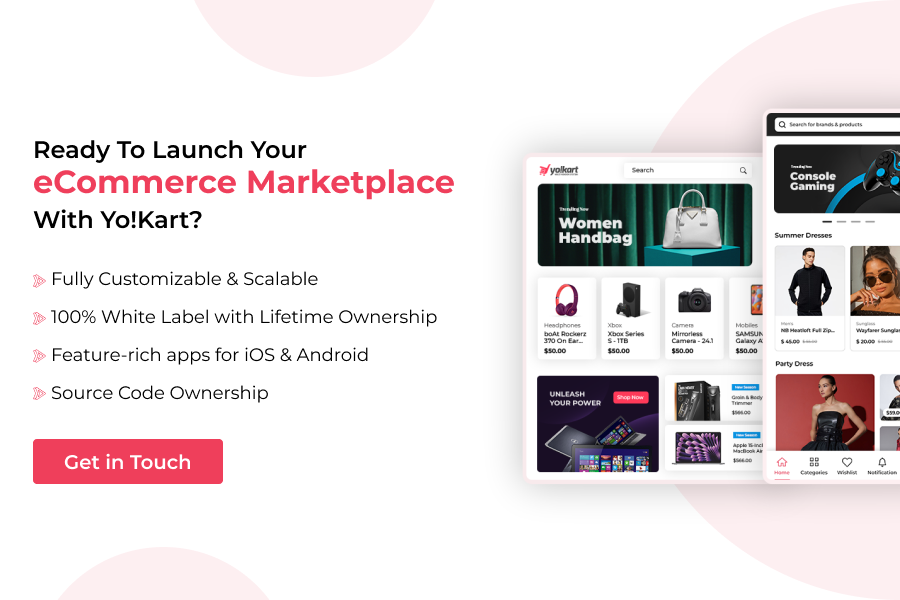The eCommerce industry has undergone a massive transformation in recent years. Businesses are no longer limited to selling products individually or through a single storefront. Multi-seller marketplaces have emerged as a game-changer, allowing multiple vendors to sell their products under one roof.
Industry insights show this trend is only going to accelerate. According to a report by Grand View Research, the eCommerce industry is expected to surpass an impressive $83.26 trillion by 2030. Further, Edge by Ascential adds that online marketplaces will account for 59% of global eCommerce sales by 2027. For entrepreneurs and startups, this momentum highlights an opportunity to launch a multi-seller eCommerce marketplace.
However, choosing the right multi-seller platform can make the difference. In this blog, we will explore the top 10 multi-seller eCommerce platforms, their features, and how they can help businesses achieve rapid growth.
Table of Contents
- What is a Multi-Seller eCommerce Platform?
- Key Advantages of a Multi-Seller eCommerce Platform
- How Does a Multi-Seller eCommerce Platform Work?
- Key Features to Look for in a Multi-Seller eCommerce Platform
- Criteria for Selecting the Best Multi-Seller eCommerce Platform
- Top 10 Multi-Seller eCommerce Platforms to Build an eCommerce Marketplace
- Conclusion
- FAQs
What is a Multi-Seller eCommerce Platform?
A multi-seller eCommerce platform—also referred to as a multi-vendor marketplace platform—is a software solution that enables entrepreneurs to launch and manage an online marketplace where multiple independent vendors can register, list their products, and sell to customers within a single digital storefront. Unlike a traditional single-vendor store that is owned and operated by one business, a multi-seller platform creates a shared ecosystem where the marketplace owner manages the overall platform while vendors independently handle their product listings, pricing, and order fulfillment.
In simple terms, this type of platform provides the technology infrastructure needed to build an online marketplace similar to Amazon, eBay, or Etsy. It includes core features like vendor dashboards, commission management, product catalog systems, payment gateway integrations, and reporting tools, from the beginning designed to streamline operations for both sellers and the marketplace operator.
Key Advantages of a Multi-Seller eCommerce Platform
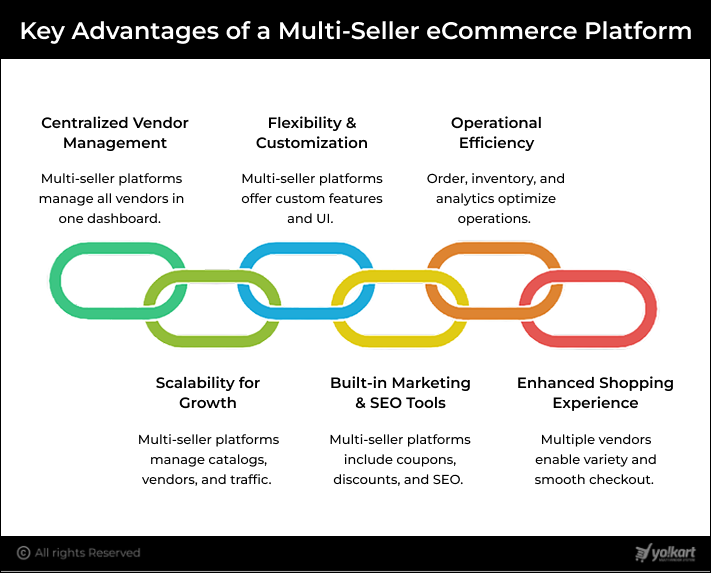
A multi-seller eCommerce platform is a complete solution that enables marketplace owners to launch and scale an eCommerce marketplace quickly. By eliminating the need for costly custom development, it empowers businesses to focus on growth and customer experience. Here are a few benefits that a multi-seller eCommerce platform brings to the table:
1. Centralized Vendor Management: A multi-seller eCommerce platform provides marketplace owners with built-in tools to seamlessly onboard, approve, and manage multiple vendors from a single dashboard. This reduces administrative overhead and ensures efficient platform governance.
2. Scalability for Growth: Unlike basic eCommerce solutions, multi-seller platforms are built to handle large product catalogs, growing vendor networks, and increasing traffic, making them future-ready for business expansion.
3. Flexibility & Customization: Unlike off-the-shelf single-vendor solutions, multi-seller eCommerce platforms often allow customization of features, workflows, and UI/UX to match unique business requirements, branding, and customer expectations.
4. Built-in Marketing & SEO Tools: Most multi-seller platforms are equipped with marketing features such as coupon engines, discount management, and SEO-friendly product pages, reducing reliance on third-party tools and improving visibility.
5. Operational Efficiency: With integrated order management, inventory syncing, and real-time analytics, marketplace owners can optimize business decisions, track performance, and ensure smooth day-to-day operations.
6. Enhanced Shopping Experience: By supporting multiple vendors under one roof, the platform ensures customers have access to diverse products, advanced filtering options, and smooth checkout processes, which improves user satisfaction.
How Does a Multi-Seller eCommerce Platform Work?
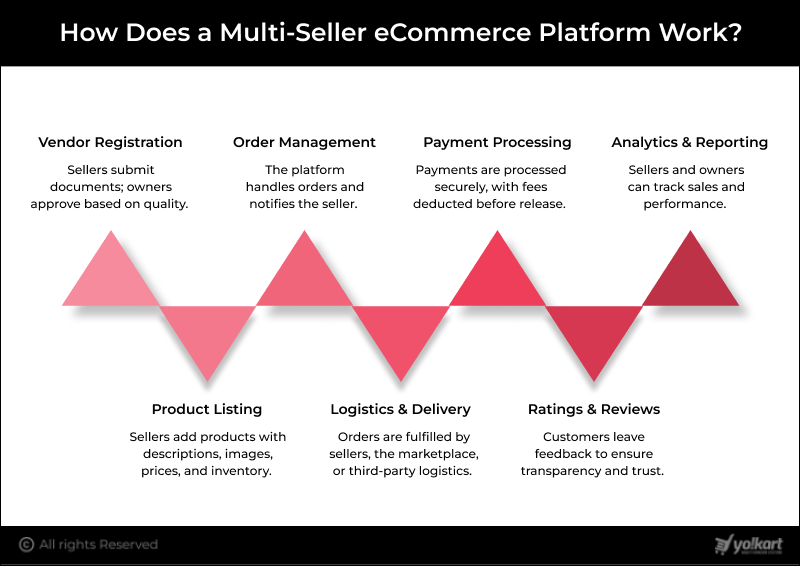
Understanding the workflow of a multi-seller platform is essential for choosing the right solution. These platforms are designed to streamline interactions between marketplace owners, sellers, and customers, ensuring that every process runs smoothly. Here’s a step-by-step overview of how they typically operate:
1. Vendor Registration: Sellers create accounts and submit required documentation. The marketplace owner can approve sellers based on criteria such as credibility and product quality.
2. Product Listing: Sellers add products to the marketplace with detailed descriptions, images, prices, and inventory information.
3. Order Management: When a customer places an order, the platform manages the transaction and notifies the relevant seller.
4. Payment Processing: Payments are processed securely. Commissions or fees are deducted before funds are released to sellers.
5. Analytics & Reporting: Both sellers and marketplace owners can track sales, monitor performance, and optimize operations.
Modern multi-seller eCommerce platforms also include dashboards, notifications, marketing tools, and integrations to ensure smooth operations for both sellers and platform owners. Platforms like Yo!Kart provide a highly intuitive workflow that simplifies these processes while offering customization for different business needs.
Key Features to Look for in a Multi-Seller eCommerce Platform
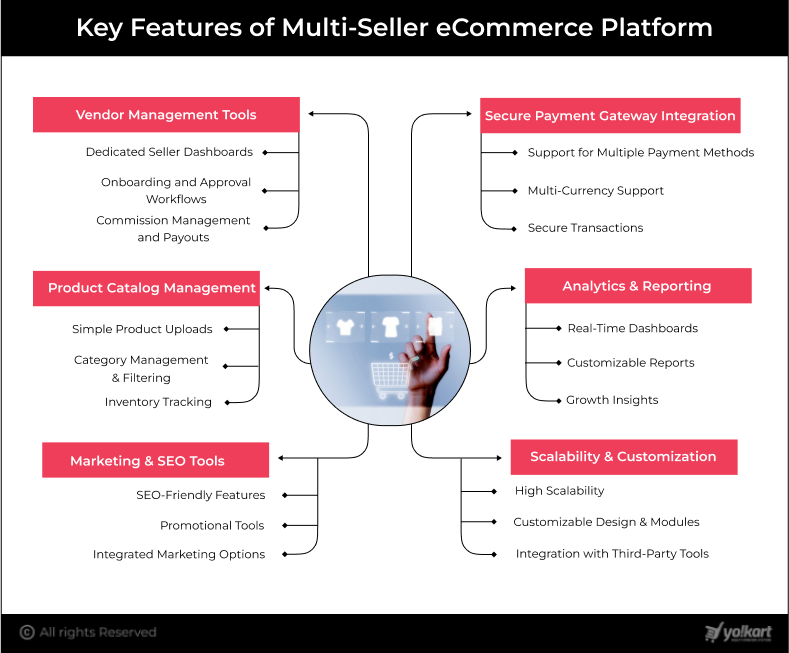
When launching or scaling a multi-seller eCommerce marketplace, the platform you choose plays a pivotal role in determining your long-term success. A robust multi-seller eCommerce platform should not only simplify day-to-day eCommerce operations but also empower vendors, streamline customer journeys, and provide room for growth. Below are the key features you should evaluate when selecting the right multi-seller eCommerce platform for your business:
1. Vendor Management Tools
Managing multiple sellers is the foundation of any multi-vendor eCommerce marketplace. The platform should offer dedicated tools to help you onboard, monitor, and support sellers effectively.
- Dedicated Seller Dashboards: Each seller should have access to their dedicated dashboard to track orders, revenue, inventory levels, customer reviews, and overall performance. A clear interface encourages sellers to stay engaged and improve their sales strategies.
- Onboarding and Approval Workflows: Streamlined onboarding ensures that new vendors can easily register, submit documents, and get approved. Approval workflows also help marketplace owners maintain quality standards and control which vendors are allowed to sell.
- Commission Management and Payouts: Automated commission tracking and flexible payout schedules (weekly, monthly, or custom) save time and reduce errors. This transparency helps in building trust between the platform and sellers.
2. Secure Payment Gateway Integration
Smooth and secure transactions are at the heart of every successful marketplace. Your platform should integrate with reliable payment gateways to cater to different customer needs.
- Support for Multiple Payment Methods: Offering a variety of payment options, such as credit/debit cards, bank transfers, Buy Now Pay Later (BNPL) services, cash, and regional digital wallets, ensures maximum convenience for customers worldwide.
- Multi-Currency Support: For global marketplaces, the ability to accept and process payments in multiple currencies enhances the shopping experience and builds credibility with international buyers.
- Secure Transactions: Compliance with PCI DSS standards, fraud detection, and SSL encryption is critical for safeguarding sensitive customer information.
3. Product Catalog Management
An organized and flexible product catalog makes it easy for vendors to showcase their products and for customers to easily find what they need.
- Simple Product Uploads: Vendors should be able to upload products in bulk with images, detailed descriptions, pricing, and SEO-friendly metadata. This reduces time-to-market and keeps the store updated.
- Category Management and Filtering: Advanced categorization, search filters, and product attributes improve navigation, helping customers find products faster and increasing conversion rates.
- Inventory Tracking: Automated inventory updates prevent overselling and notify vendors when stock is running low, ensuring seamless operations.
4. Analytics & Reporting
Data-driven decision-making is key to scaling an online marketplace. The platform should provide robust analytics for both vendors and admins.
- Real-Time Dashboards: Insights into sales, revenue, customer behavior, and traffic allow both sellers and marketplace owners to track performance at a glance.
- Customizable Reports: Detailed reports on vendor performance, product popularity, abandoned carts, and marketing campaigns can help identify opportunities and weaknesses.
- Growth Insights: Access to trends and predictions supports better decision-making for inventory planning, pricing strategies, and promotional activities.
5. Marketing & SEO Tools
Without visibility and effective promotion, even the best products may struggle to sell. A marketplace platform should include features to boost discoverability and engagement.
- SEO-Friendly Features: Optimized product URLs, meta descriptions, schema markup, and sitemaps make it easier for search engines to index and rank product pages.
- Promotional Tools: Built-in features like discount codes, flash sales, gift cards, and loyalty programs encourage repeat purchases and improve customer retention.
- Integrated Marketing Options: Tools for email campaigns, social media sharing, and affiliate marketing can help vendors expand their reach without relying solely on external platforms.
6. Scalability & Customization
As your business grows, so will the number of vendors, products, customers, and transactions. Your chosen platform should be able to scale seamlessly without performance issues.
- High Scalability: From managing a few vendors at launch to handling thousands of sellers and millions of products, the platform should offer a robust architecture that adapts to demand.
- Customizable Design & Modules: Every marketplace has unique needs. The ability to customize storefront design, vendor dashboards, and add-on modules ensures that the platform aligns with your brand identity and business model.
- Integration with Third-Party Tools: Support for CRM, ERP, shipping solutions, and marketing automation tools allows you to create an ecosystem that grows with your business.
Build a Powerful Marketplace With a Feature-Rich Multi-Seller eCommerce Platform
Criteria for Selecting the Best Multi-Seller eCommerce Platform
Not all multi-seller eCommerce platforms are built the same. While many solutions promise scalability and ease of use, the right choice depends on how well a platform aligns with your business goals, vendor needs, and customer expectations. Before finalizing a solution, it’s important to carefully evaluate the following criteria:
1. Cost and Pricing Model
Budget is one of the most decisive factors in selecting a multi-seller marketplace platform. Different solutions come with varying pricing structures, and businesses must evaluate both short-term affordability and long-term financial implications.
- Pricing Structures: Platforms may offer one-time purchase licenses, subscription-based models, or commission-based pricing where the platform takes a percentage of every transaction. Each model has its pros and cons depending on your revenue strategy.
- Long-Term Costs: Beyond the initial cost, businesses should factor in expenses for scalability, upgrades, customizations, and third-party integrations. A solution that looks inexpensive upfront may become costly as you expand.
- Value for Money: It’s essential to balance cost with the features provided. The cheapest option may lack critical tools, while the most expensive one may include features you don’t necessarily need at the start.
2. Technical Support and Ease of Use
An advanced multi-seller eCommerce platform is only valuable if it’s usable for both marketplace owners and vendors. Similarly, reliable technical support ensures that your marketplace runs smoothly even when issues arise.
- 24/7 Customer Support: Look for a platform that offers round-the-clock support through multiple support channels such as chat, email, and phone, ensuring quick resolution of critical issues.
- Documentation and Training: Comprehensive manuals, video tutorials, and vendor guides simplify onboarding for sellers and admins.
- Ease of Use: The interface should be intuitive, reducing the learning curve for vendors who may not be tech-savvy. User-friendly dashboards, drag-and-drop features, and guided workflows can significantly improve adoption.
3. Security and Compliance
Security is non-negotiable in a multi-vendor eCommerce marketplace. Customers and vendors alike need assurance that their data and financial transactions are safe.
- Regulatory Compliance: Ensure that the multi-vendor eCommerce platform complies with international standards such as GDPR for data privacy and PCI DSS for payment security. Non-compliance can lead to heavy penalties and loss of trust.
- Robust Security Features: Features such as SSL certificates, two-factor authentication, and role-based access control are essential for preventing unauthorized access and cyber threats.
- Data Protection: End-to-end encryption and secure payment gateways protect sensitive information, while backup and disaster recovery systems ensure business continuity.
4. Mobile Responsiveness and Apps
With a significant portion of eCommerce traffic coming from mobile devices, mobile-friendliness is no longer optional; it’s a necessity.
- Responsive Design: The multi-seller eCommerce platform that you choose should automatically adjust to different screen sizes, ensuring seamless user experiences across smartphones, tablets, and desktops.
- Dedicated Mobile Apps: Offering Android and iOS apps for vendors and customers can improve engagement and increase repeat sales. Apps with features like push notifications and mobile payments make shopping more convenient.
- Performance Optimization: Fast-loading pages, smooth navigation, and mobile-friendly checkout processes help reduce cart abandonment on mobile devices.
5. Scalability
Your platform should grow with your business. As the marketplace expands, it must handle increasing vendor numbers, product listings, and customer traffic without compromising performance.
- Vendor and Product Growth: The system should support thousands of vendors and millions of products without slowing down.
- Traffic Handling: High-performing platforms are built to handle traffic surges during peak seasons or promotions.
- Future-Proof Architecture: Look for a solution that allows you to integrate new technologies, add features, and adapt to changing market trends as your business evolves.
- Global Expansion: A scalable multi-seller eCommerce platform should allow marketplace owners to expand to new regions with features like multilingual support, multi-currency functionalities, localized payment gateways, and compliance with international regulations.
Top 10 Multi-Seller eCommerce Platforms to Build an eCommerce Marketplace
The eCommerce industry is evolving rapidly as more businesses adopt marketplace models similar to Amazon, Etsy, and eBay. But choosing the right multi-seller eCommerce platform is often the biggest challenge. Here’s a detailed breakdown of the top 10 multi-seller eCommerce platforms for 2025, with an in-depth look at their features, pros and cons, and best use cases:
1. Yo!Kart
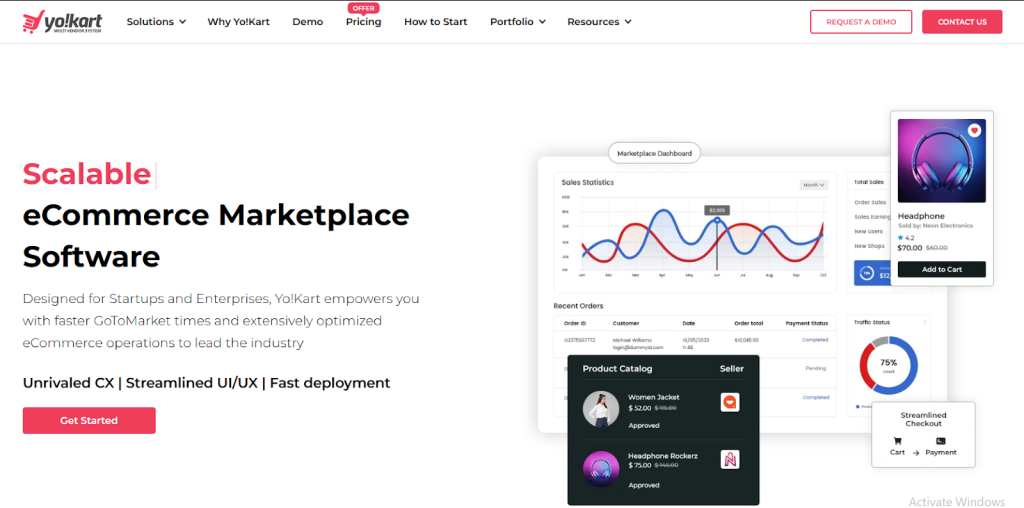
Yo!Kart is a purpose-built multi-seller eCommerce platform designed specifically for entrepreneurs and growing businesses to launch and scale eCommerce platforms like Amazon or Etsy. Unlike other solutions, which require third-party add-ons to enable multi-seller functionality, Yo!Kart offers all essential marketplace features pre-integrated right out of the box, saving both time and cost. The platform supports a wide range of business models, including B2B, B2C, and others, giving marketplace owners the flexibility to adapt as their business grows.
Yo!Kart emphasizes scalability, allowing businesses to seamlessly expand their vendor base, operational zones, and customer reach without compromising performance. It also supports multilingual and multi-currency functionalities, making it suitable for businesses planning international expansion. Additionally, Yo!Kart is highly customizable and offers lifetime ownership with a one-time payment model, unlike subscription-based alternatives. This makes it a cost-effective alternative for businesses that require complete control over their marketplaces while minimizing recurring expenses.
Key Features:
- Advanced vendor dashboards with order, sales, and commission tracking.
- Built-in support for multi-currency and multilingual marketplaces.
- Multiple secure payment gateways and split payment options.
- SEO-friendly product pages, meta tags, and schema support.
- Powerful analytics for both admins and vendors.
- Native mobile apps for both Android and iOS.
Pros:
- Completely white-label solution that supports unique branding.
- No recurring commission fees (unlike SaaS models).
- Self-hosted solution with control over hosting.
- Scalable architecture capable of handling growing operations.
- Intuitive and simple-to-use vendor and admin dashboards.
- Customization-ready for unique business models.
- Free instant & scheduled demo sessions available.
- 1 year of free dedicated technical support post-purchase.
Cons:
- Learning curve for newcomers due to advanced features and functionalities.
Why Choose Yo!Kart: While other platforms like Shopify, BigCommerce, or Magento rely on third-party extensions to deliver true multi-seller functionality (often at a high ongoing cost), Yo!Kart is a dedicated, ready-to-launch multi-seller eCommerce platform. It eliminates dependency on plugins, offers lifetime ownership, and delivers the balance between affordability, scalability, and customization that startups need.
Schedule a Free Personalized Demo Session for Yo!Kart
2. Shopify Plus
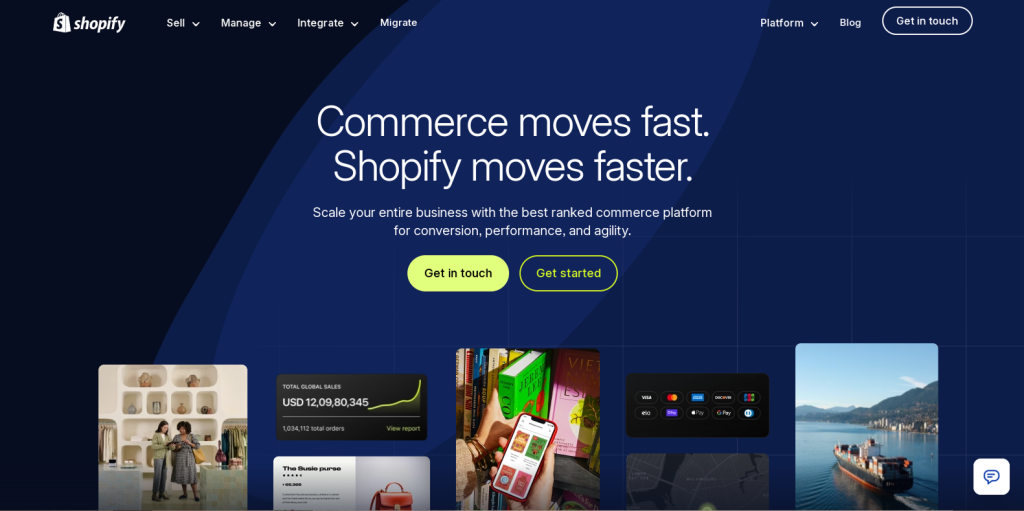
Shopify Plus is Shopify’s enterprise-grade offering. While the standard Shopify platform is primarily built for single-vendor eCommerce operations, businesses aiming to create a multi-seller marketplace can extend its functionality through third-party integrations such as the Webkul Multi-Vendor Marketplace app.
Shopify Plus also provides advanced customization through APIs, automation tools, and integrations, which can help streamline vendor onboarding, product management, and order workflows. Combined with its robust infrastructure and 24/7 priority support, Shopify Plus becomes a powerful option for businesses seeking a SaaS-based solution with recurring costs.
Key Features:
- Vendor onboarding through apps
- Strong payment security
- Analytics dashboards,
- Powerful marketing tools
Pros:
- 24/7 customer support and a large partner ecosystem.
- Easy to scale with enterprise hosting.
- Extensive library of third-party apps.
Cons:
- Multi-vendor functionality is not native; it requires separate integrations
- Monthly subscription fees add up as vendors and features grow
- Limited customization compared to open-source platforms
3. Magento (Adobe Commerce)
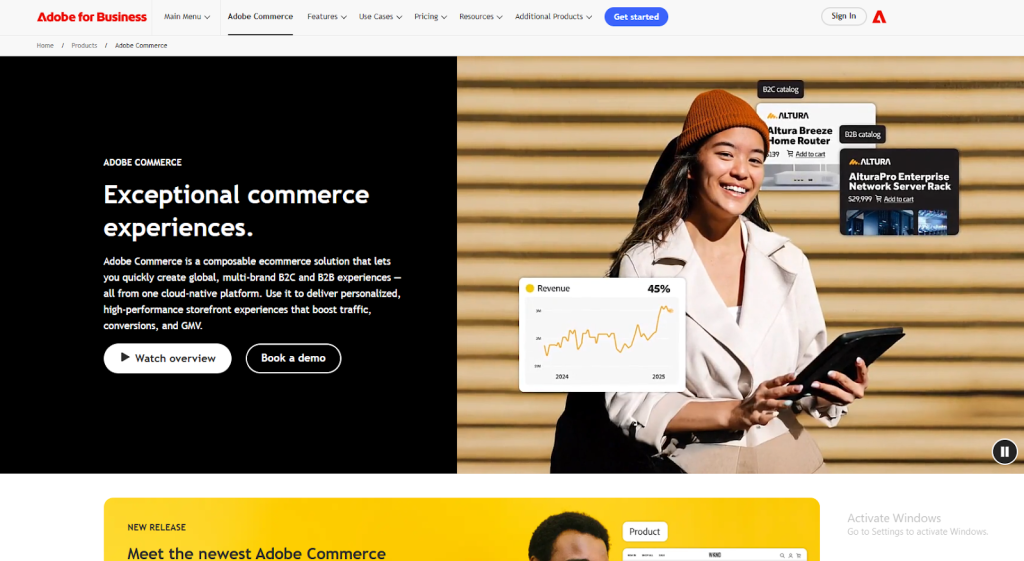
Magento, now branded as Adobe Commerce, is a powerful open-source eCommerce platform that is well-suited for businesses seeking complete control over their online marketplace. By default, Magento is not a multi-vendor eCommerce platform, but it can be transformed into one through marketplace extensions like CedCommerce Marketplace, Webkul Multi-Vendor Marketplace, or other third-party modules.
What makes Magento stand out is its unparalleled customization potential. Unlike many SaaS-based platforms, Magento allows developers to create bespoke marketplace features tailored to a business’s exact requirements. However, with its flexibility comes complexity. It typically requires a skilled development team and ongoing maintenance, making it more resource-intensive compared to SaaS solutions.
Key Features:
- Inventory control
- Advanced vendor management
- Custom design capabilities
- Strong analytics
Pros:
- Highly flexible and scalable with enterprise-grade features.
- Massive developer community and extension marketplace.
- Suitable for large-scale and complex marketplaces.
Cons:
- High setup, development, and maintenance costs.
- Steep learning curve for non-technical teams.
4. CS-Cart Multi-Vendor
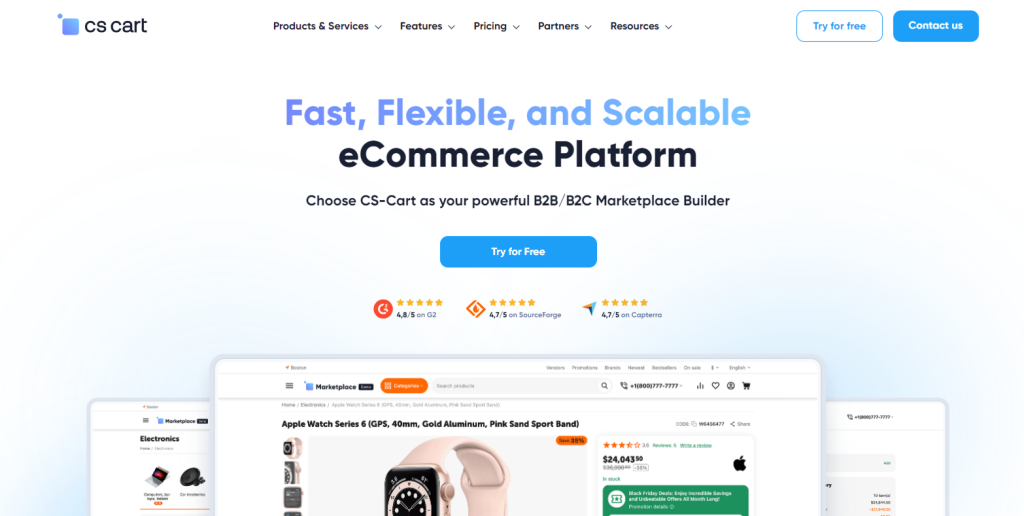
CS-Cart Multi-Vendor is a dedicated multi-vendor marketplace platform designed for small to medium-sized marketplaces. The software includes a wide range of built-in marketplace features, such as vendor-specific microsites, payout systems, flexible commission structures, promotional tools, and customer management.
In addition to functionality, CS-Cart emphasizes user-friendliness with its intuitive interface, drag-and-drop admin panel, and responsive design. It also supports a variety of payment gateways and shipping methods, giving both vendors and customers flexibility and convenience.
Key Features:
- Vendor dashboards
- Shipping integrations
- Commission management
- Approval workflows
Pros:
- Affordable with lifetime licensing
- Rich feature set from the start
- Straightforward admin and vendor interfaces
Cons:
- Limited design flexibility compared to Magento or Yo!Kart
- May require custom development for advanced use cases
- Not suitable for established businesses or large enterprises
5. BigCommerce with Multi-Vendor Extensions
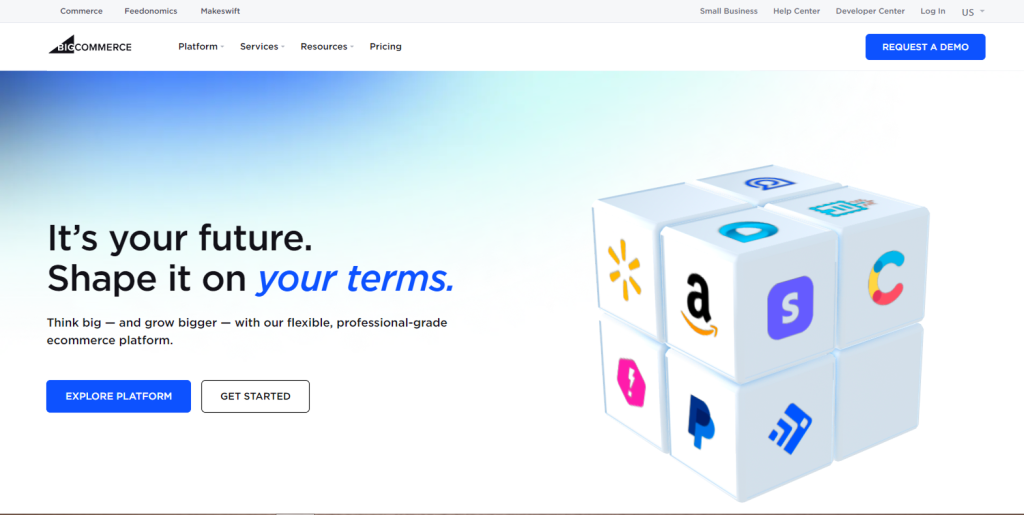
BigCommerce is a popular SaaS-based eCommerce platform that provides excellent scalability and security. However, it does not offer multi-vendor functionality by default; businesses must rely on third-party extensions to transform it into a marketplace.
Through these integrations, marketplace owners can allow multiple vendors to create accounts, manage their product listings, handle orders, and process shipping. The software offers a strong API ecosystem, making it possible to integrate with third-party services for payments, shipping, ERP, CRM, and more. The reliance on third-party apps for marketplace functionality may introduce additional costs and limitations compared to purpose-built solutions
Key Features:
- Secure hosting
- Payment and shipping integrations
- SEO tools
- Strong inventory management
Pros:
- Cloud-hosted with automatic updates and maintenance.
- Scales easily with traffic spikes.
- Native SEO and marketing features.
Cons:
- Requires extensions for vendor functionality
- Ongoing monthly subscription costs keep adding up
- Not enough scalable and customizable
6. Sharetribe
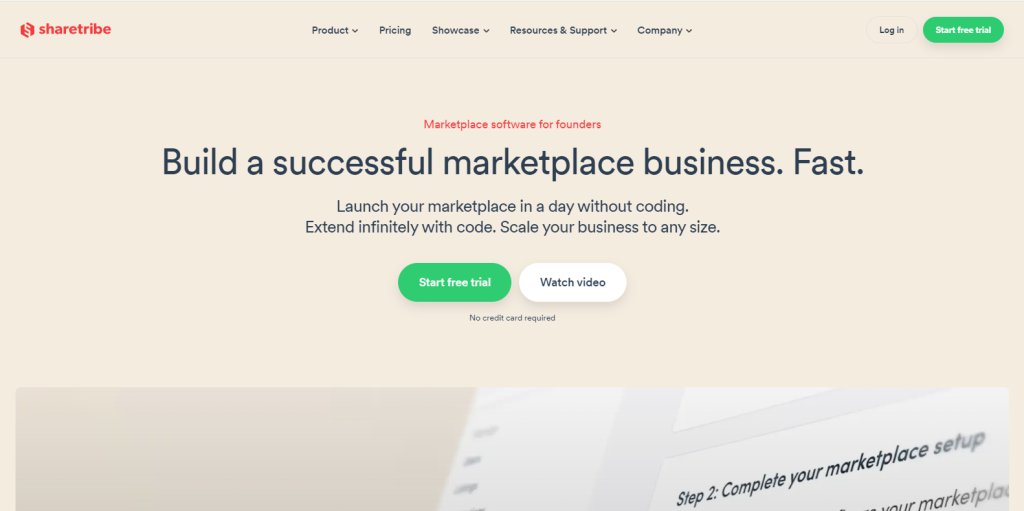
Sharetribe is a niche marketplace software that focuses on building service and peer-to-peer product marketplaces. Its primary strength is simplicity and speed of deployment; businesses can quickly launch marketplaces for rentals, bookings, or freelance services without needing advanced development.
The platform comes with built-in features for vendor management, user profiles, messaging, booking calendars, payment processing, and commission handling. This makes it particularly popular among startups and entrepreneurs looking to test and validate a marketplace idea quickly. Because Sharetribe is designed for niche use cases like rentals, bookings, and services, it may not be as feature-rich for traditional multi-vendor product marketplaces.
Key Features:
- Booking and scheduling tools
- Vendor onboarding
- Mobile-responsive design
- Integrated payments
Pros:
- Quick to launch with minimal setup.
- Flex edition provides customization for developers.
- Clean, user-friendly design.
Cons:
- Limited functionality for large product-based marketplaces.
- Prior coding knowledge is required for advanced use.
7. Marketplacer
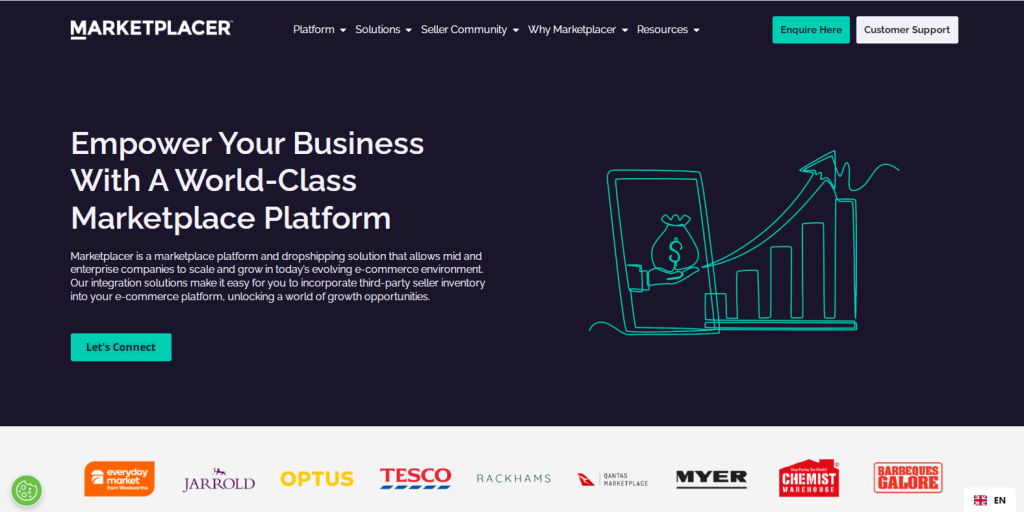
Marketplacer is an enterprise-grade platform that enables businesses to launch large-scale marketplaces with advanced vendor onboarding and analytics. It is particularly popular among B2B organizations and enterprises that require API-driven integrations for complex operations.
The platform also excels in API-driven flexibility, enabling seamless integration with enterprise systems such as ERP, CRM, POS, and logistics solutions. Its infrastructure is designed to scale globally, handling high volumes of products, transactions, and users without compromising speed or reliability. However, Marketplacer is typically more resource-intensive and suited to enterprise-level businesses rather than startups or small ventures.
Key Features:
- Vendor onboarding
- API-driven integrations
- Commission and payment management
- Robust reports and analytics tools
Pros:
- Extremely scalable and enterprise-ready
- API-first architecture supports advanced integrations
- Strong reporting and analytics tools
Cons:
- High cost of entry, not suitable for startups
- Longer setup and deployment times
8. Arcadier
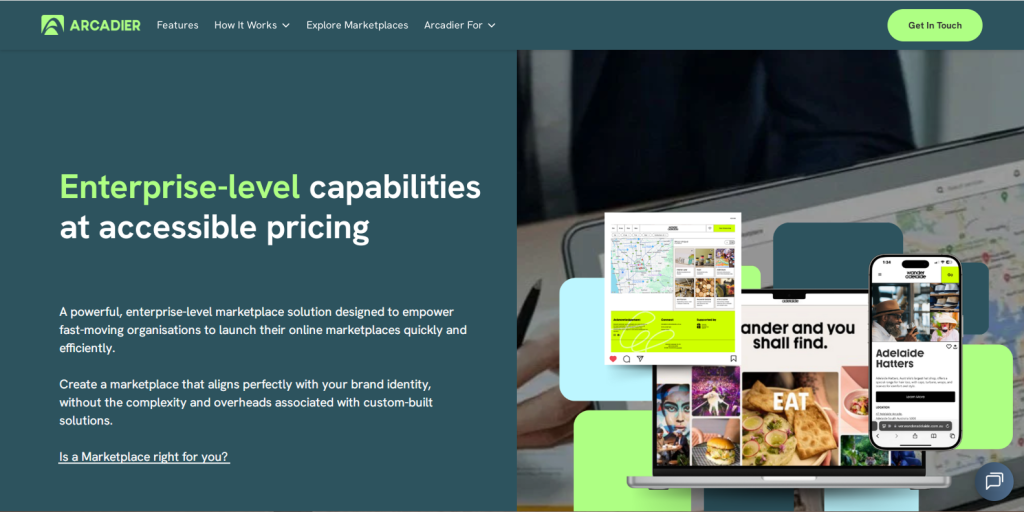
Arcadier is a SaaS-based multi-vendor marketplace platform that allows businesses to create marketplaces with minimal setup time. It is widely used by entrepreneurs, SMEs, and organizations that want a fast and cost-effective way to launch an online marketplace without heavy development requirements.
It provides a variety of ready-to-use templates and customizable themes, enabling marketplace operators to create marketplaces for retail products, rentals, services, or bookings. Overall, Arcadier is best suited for startups and small to mid-sized businesses that value ease of use, quick setup, and affordability over deep customization.
Key Features:
- Multi-language and Multi-currency support
- Customizable themes
- Dedicated Vendor dashboards
Pros:
- SaaS model with quick setup.
- Affordable pricing for small businesses.
- Good for niche international markets.
Cons:
- Limited flexibility compared to open-source platforms
- Advanced features often require developer support
- Recurring monthly or annual subscription costs
Secure a Scalable and Future-Ready Multi-vendor Marketplace Platform
9. WCFM Marketplace (WooCommerce)
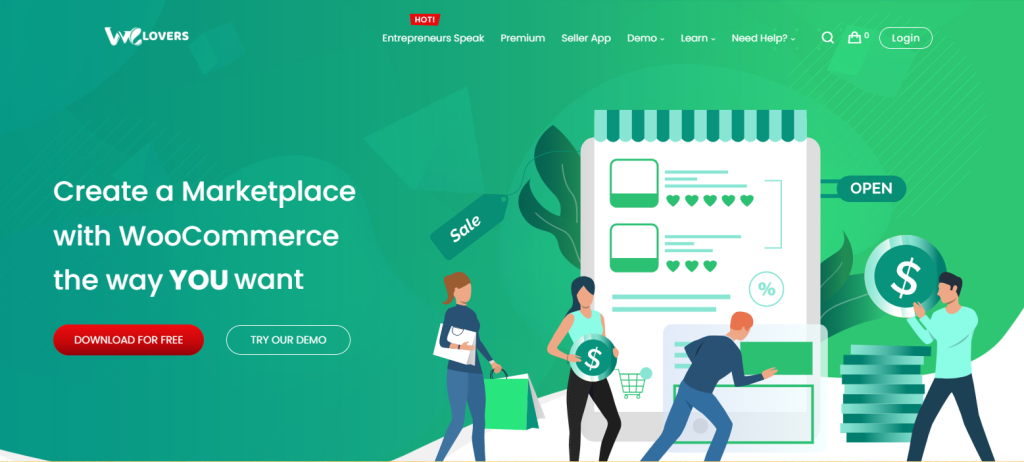
WCFM Marketplace is a popular multi-vendor plugin built on WooCommerce, making it a natural choice for WordPress users. It allows businesses to transform their WooCommerce stores into fully functioning marketplaces with features like vendor dashboards and commission management.
One of WCFM Marketplace’s biggest strengths is its flexibility and extensibility. Since it is built on top of WooCommerce and WordPress, businesses can take advantage of the vast plugin ecosystem. However, as with most WordPress-based solutions, running a large-scale marketplace on WCFM may require significant server resources and ongoing technical maintenance.
Key Features:
- Vendor dashboards
- Commission structures
- Vendor approval
- Product management tools
Pros:
- Very affordable.
- Wide availability of WordPress plugins.
- Strong community support.
Cons:
- Requires WordPress and WooCommerce expertise.
- Scalability issues for large marketplaces.
10. X-Cart Multi-Vendor
X-Cart is a PHP-based marketplace platform that allows businesses to build both small and large marketplaces. Its flexibility lies in its open-source nature, which enables developers to create custom features and workflows.
With the X-Cart Multi-Vendor add-on, a standard X-Cart store can be transformed into a fully functional multi-vendor marketplace. Since it is open-source, businesses require extensive technical expertise to build custom features, integrate third-party APIs, and create marketplace experiences.
Key Features:
- Separate vendor dashboards
- Simplified product listings
- Shipping/payment integrations
- High customization capabilities
Pros:
- Highly flexible and scalable.
- Strong built-in features for vendor management.
- Ownership model without recurring SaaS fees.
Cons:
- Outdated interface compared to modern SaaS platforms
- Higher technical barrier for non-technical users
- Prior coding knowledge required or dedicated development resources
Comparison of Top Multi-Seller eCommerce Platforms
Choosing the right multi-seller eCommerce platform can be overwhelming, given the wide variety of options available in the market. Each platform comes with its own strengths, pricing models, and limitations, making it crucial to evaluate them against consistent benchmarks. To simplify your decision-making, we’ve created a side-by-side comparison that highlights the most important factors entrepreneurs should consider—such as deployment type, scalability, vendor management capabilities, and long-term cost implications.
This comparison not only shows how leading solutions stack up against each other but also makes it easier to identify which platform aligns best with your business model, whether you’re a startup looking for a quick launch or an established enterprise planning to scale globally.
| Software | Deployment Model | Multi-Vendor Support | Scalability | Pricing Model | Best For |
| Yo!Kart | Self-hosted | Built-in, native | Highly scalable, global-ready | One-time license | Startups, SMBs & Enterprises |
| Shopify Plus | SaaS-based | Via third-party apps | Limited by SaaS constraints | Subscription + app fees | Businesses already on Shopify |
| Magento | Open Source | Extensions required | High | High dev & maintenance costs | Enterprises w/ dev teams |
| CS-Cart | Self-hosted | Built-in | Scalable w/ hosting upgrades | One-time license | SMBs |
| BigCommerce | SaaS-based | Extensions required | Limited flexibility | Subscription + extension fees | Low-maintenance SaaS seekers |
| Sharetribe | SaaS-based | Built-in (services) | Less flexible enterprise retail | Subscription | Service/P2P marketplaces |
| Marketplacer | SaaS-based | Built-in | High | Enterprise-level pricing | B2B enterprises |
| Arcadier | SaaS-based | Built-in | Low customization | Subscription | Startups testing niches |
| WCFM Marketplace | Self-hosted | Plugin-based | Hosting dependent | Free + paid plugins | Small WordPress shops |
| X-Cart | Open Source | Built-in | Requires strong server management | One-time license | SMBs with dev teams |
Choose a Platform that Suits Best with Your Business Requirements
Recommended Choice:
When evaluating the top multi-seller eCommerce platforms, Yo!Kart consistently stands out as the most complete and scalable solution for startups and growing businesses. Unlike SaaS platforms that rely heavily on third-party apps for multi-vendor functionality, Yo!Kart comes with native multi-vendor features built in, making it faster, cost-effective, and easier to manage. Its self-hosted architecture ensures full ownership, no recurring commissions, and the flexibility to scale as your marketplace grows.
Why Yo!Kart is the Recommended Choice:
- 100% White Label: Build your marketplace under your own brand identity without third-party visibility.
- All-in-One Multi-Vendor Features: Vendor dashboards, commission management, split payments, multi-currency support, and SEO tools are ready out of the box.
- Self-Hosted with One-Time License: One-time licensing with lifetime ownership and hosting flexibility ensures long-term savings compared to SaaS platforms with ongoing fees.
- Scalable & Future-Ready: Capable of handling thousands of vendors and millions of products without performance issues.
- Customizable & Flexible: Offers options for UI/UX customization, add-on modules, and integrations with third-party tools to match unique business requirements.
- Mobile Apps: Native mobile apps available for both Android and iOS to maximize reach.
- Free Demo Availability: Explore the platform’s functionality risk-free before committing.
- 1 Year Free Technical Support: Dedicated support to help you launch and stabilize your marketplace smoothly.
Real-World Marketplaces Built with Yo!Kart:
1. UNI Diamonds – Israel-based B2B diamond trading platform featuring AI-powered price calculators, diamond auctions, and trend analysis tools.
2. Voyij – A travel marketplace connecting travelers with local tour operators, offering features like tiered pricing, activity time slots, and multiple pickup locations.
3. WaterSorted – A New Zealand-based B2B marketplace focused on water management solutions, providing a centralized hub for sourcing high-quality products for various water systems.
4. Tajer – A multi-category eCommerce marketplace in Qatar, connecting consumers with top-tier local and global brands across fashion, beauty, home goods, and electronics.
5. 4GoodVibes – A marketplace dedicated to handmade, unique, and vintage products, promoting sustainability and supporting artisans and craftsmen.
By choosing Yo!Kart, businesses not only get a ready-to-launch multi-vendor platform but also a solution that balances affordability, scalability, and operational efficiency, making it the ideal choice for startups, SMEs, and large enterprises looking to enter the multi-seller marketplace space.
Conclusion
Multi-seller marketplaces are reshaping the eCommerce landscape, offering opportunities for rapid growth and diversified revenue streams. Hence, choosing the right multi-vendor eCommerce platform is crucial for business success. Robust multi-seller eCommerce platforms like Yo!Kart provide a perfect balance of features, scalability, and ease of use, making them an ideal choice for startups and growing businesses alike. By understanding your business needs and comparing the top multi-seller eCommerce platforms, you can launch a successful multi-vendor marketplace that attracts both vendors and customers efficiently.
FAQs
Q 1. What is a multi-seller eCommerce platform?
Ans. A multi-seller eCommerce platform is ready-to-use software that enables businesses to launch an online marketplace, where multiple vendors can sell their products, quickly without investing heavily in custom development. It provides built-in eCommerce features, ensuring a quick, cost-effective, and scalable way to manage sellers and customers.
Q 2. Which is the best multi-seller eCommerce platform for startups?
Ans. For startups and SMEs, Yo!Kart stands out as the best multi-seller platform because it offers built-in vendor management, one-time licensing (no recurring commission fees), and scalability for long-term growth. It is designed to help new businesses launch quickly without heavy development costs.
Q 3. How do I choose the right multi-vendor marketplace software?
Ans. When selecting a multi-seller platform, consider factors like pricing model (subscription vs. one-time license), ease of use, vendor management features, scalability, mobile responsiveness, and customer support. Evaluating these factors ensures your platform can support both immediate needs and future growth.
Q 4. What is the cost of building a multi-seller eCommerce marketplace?
Ans. The cost depends on the platform you choose. SaaS-based platforms typically charge monthly subscriptions plus app fees, while self-hosted platforms like Yo!Kart require a one-time license fee. Over the long run, one-time cost models like Yo!Kart are often more cost-effective for growing businesses.




